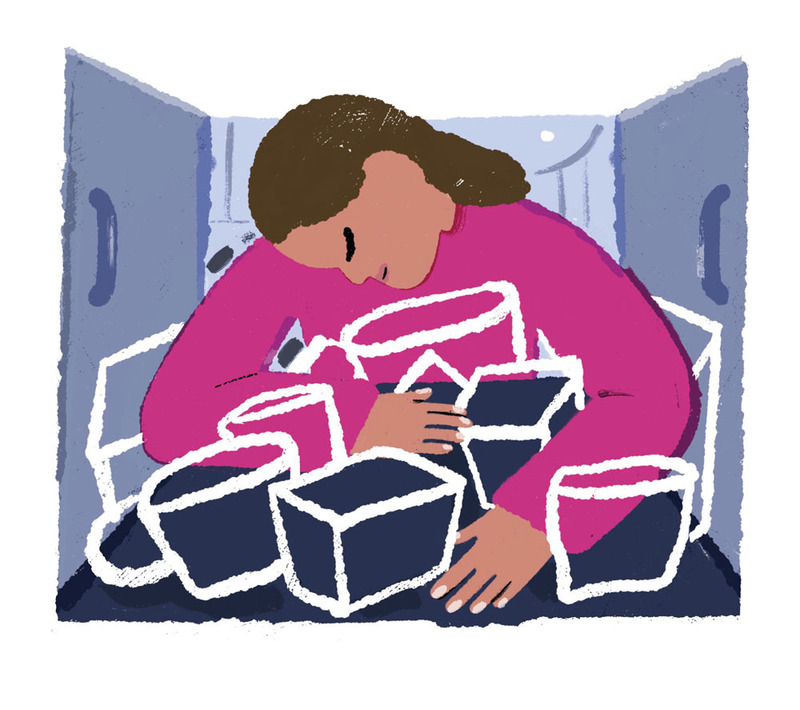 Illustration by Tallulah Fontaine
Illustration by Tallulah Fontaine
I store my plastic food containers in an overhead cabinet beside my kitchen sink. During weekly meal preparation, I draw them down onto the counter below. One of the containers is circular and has a rubber-edged lid. A few are rectangular. Most are squares with translucent red or blue tops and transparent bottoms.
Growing up, my family stored such containers in a low cabinet where we kids could reach them easily. Our kitchen chore wheel was divided into quadrants, one per child: washing, loading, unloading and week off. After “week off,” unloading the dishwasher was the preferred rotation; it was cleaner than the alternatives and could be completed before dinner. “Bowling for Tupperware!” my brother Austin would say when assigned to unload, winding his arm like a pitcher, miming — and sometimes actualizing — a container’s release through the cabinet’s open door.
My brothers and I knew where most kitchen items were stored. Less frequently used pieces — a mixer attachment, a glass salad bowl — belonged to overhead cabinets. Daily use items such as cereal bowls, plates and utensils were kept within reach. This division of things sometimes left a remainder, a stray or two on the counter that said, I can’t reach that high, or I don’t know where this goes.
Our plastic storage containers lived at shin level. We kids knew their sizes and texture best of all the dishware; they were mostly used in our school lunch boxes. The low position made their cabinet the most likely one to escape our parents’ tidying tendencies. If the other kitchen shelves were like classrooms organized into straight rows, the plastic-container cabinet was like a first-grade lunch table on the cusp of recess.
Since then, I have encountered kitchens with a variety of storage arrangements. During a postgraduate service year, I lived with 13 housemates in a large former convent whose kitchen featured the mother of all container drawers. Living on a strict budget, my housemates and I packed lunches from our leftovers. Mornings saw us hustling to match bottoms to tops. It always took us a few moments to compare the sizes of the circles, squares and rectangles. Three of my housemates taught elementary school just across the parking lot; even their students were learning more advanced skills than we were using.
We could have eliminated the morning matching task if we had simply clamped the lids and bottoms together, but we did not adhere to such organizational schemes. Even today, in my own kitchen, I am never confident a container is completely dry, even after I towel into the crevices of its lid. Because I store my containers in a dark cabinet, clamping lids onto bottoms or nesting pieces merely for the sake of keeping order seems like I’m inviting mold. Instead, treating each piece as a free agent, I toss them into the cabinet where they land at oblique angles, maximizing the surface area for drying.
I know my system has consequences. Piled without regard for structural engineering, the containers rest on each other precariously. I crack the cabinet door open as if heeding an airline attendant’s reminder that overhead items may have shifted in flight. I suspect the door might be the linchpin holding the pile in place. Whenever my containers topple onto the counter below, I consider it a natural event, like a raincloud unburdening itself.
My plastic containers share a shelf with my spices, which is like pairing messy roommates with neat ones. If the plastics never make their beds, why insist the spices organize their bookshelves? My mother does. She arranges her spices alphabetically. And when I grope for garlic powder in my own kitchen, only to emerge with a second canister of nutmeg, I think, maybe she’s onto something. However, given my spices’ proximity to such recklessness, it seems better to acquiesce to chaos. One time I opened the cabinet and my seasoned salt took a nosedive as if attempting a technique it had learned from its rowdy roommate. Unfortunately, lacking a storage container’s resilience, the jar’s lid cracked.
I feel a kinship toward my kitchen plastics cabinet: a contentedness in its aversion to organization; a transparency in its unkemptness. It’s not a place of aesthetics but of utility. Without performing an inventory, I suspect some of my lids lost their mates long ago. However, like the solitary socks in my sock drawer, they endure. Within the kitchen, a place of precision, of measurements, temperatures and timers, of many wrongs and rights, the cabinet offers a carefree respite, permission for experimentation and mistakes.
Rarely, maybe once a year, I feel an urge to organize this space, but find that doing so is like arranging my shoe rack: All evidence of my effort vanishes within two days. Austin’s childhood cry, “Bowling for Tupperware!” was well intuited; plastic storage containers are destined for disarray. The cabinet holds them over my head like thought bubbles waiting to be filled. Within reach, it’s a place of unpredictability and hope.
Erin Buckley lives in Richmond, Virginia, where she works as an occupational therapist.